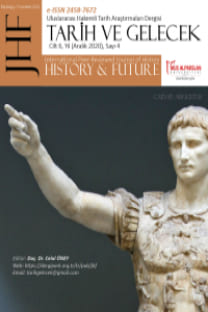Kubilay Han’ın Ordusu Karşısında Shikken (Naip) Hojo Tokimune
Hojo Tokimune, Japonya, Hojo Klanı, Shikken, Kamakura
Shikken Hojo Tokimune Against Khublai Khan’s Army
Hojo Tokimune, Japan, Hojo clan, Shikken, Kamakura,
___
- Asakawa, K., The History of Nations Japan v.7, P.F. Collier&Son Publishers, New York, 2014.
- Beasley, W. G., The Japanese Experience, Wiedenfeld&Nicolson, London, 1999.
- Brownlee, John, “Crisis as Reinforcement of The İmperial Institution, The Case of The Jokyu Incident, 1221”, Monument Nipponica, C. 30, S.2, 1975, ss.193-201.
- Brownlee, John, “The Shokyu War and The Political Rise of The Warriors”, Monumenta Nipponica, C.24, S.1/2, 1969, ss.59-77.
- Chase, Kenneth W., “Mongol Intentions Towards Japan in 1266: Evidence from A Mongol Letter to The Sung””, https://chinajapan.org/articles/09.2/09.2chase13-23.pdf, (05.10.2020).
- Cobbing, Andrew, Kyushu Gateway to Japan, Global Orienting, Folkenstone, 2009.
- Conlan, Thomas, In Little Need of Divine Intervention, Takezaki Suenaga’s Scrolls of The Mongol Invasions, East Asia Program Cornell University Ithaca, New York, 2001.
- Davis, Paul K., 100 Decisive Battles From Ancient Times to The Present, Oxford University Press, New York, 2001.
- Delgado, James, Kubilay Han’ın Kayıp Donanması, Çeviren Merve Tosun, Tarih&Kuram Yayınevi, İstanbul, 2017.
- Eberhard, W., Uzakdoğu Tarihi, TTK Yayınları, Ankara, 1992.
- Friday, Karl, “They Were Soldiers Once The Early Samurai and The İmperial Court”, War and State Building in Medieval Japan, Editör: John A. Freejohn and Frances McCall Resenbluth, Standford University Press, California, 2010.
- Hane, Mikiso, Premodern Japan, Westviev Press, USA, 1991.
- Henshall, Kenneth G., A History of Japan: From Stone Age to Superpower, Palgrave Macmillan; New York, 2004.
- Hosokawa, Shigeo, 鎌倉幕府の滅亡(Kamakura Bakufu no Metsubou- Kamakura Bakufu’nun Yıkılışı),Yoshikawa Publishing, Japan, 2011.
- Kazuhiko, Sato- Sakae Taniguchi, 吾妻鏡事典(Azuma Kagami Jiten-Azuma Kagami Sözlüğü), Tokyoshuppan Publishing, Tokyo, 2017.
- Kawazoe, Shoji, 元寇防塁編年史料(Genkoborui Hennen Shiryou- Genko Borui Tarihi Belgeleri), FukuokaKyouikuiinkai pub., Fukuoka, 1971.
- Kawazoe, Shoji, 蒙古襲来研究史論(Moko Shurai Kenkyu Shiron, Moğol İstilası Araştırmaları Tarihi), Yuzankaku Publishing, Tokyo, 1977.
- Keigetsu, Ōmachi, 鎌倉武士(Kamakura Bushi, Kamakura Savaşçıları), Kogakukan Book Store, 1909.
- Kitaoka, Masatoshi, 蒙古襲来の真実 (Mouko Shuurai no Shinjitsu-Moğol İstilasının Gerçekleri), V2 Solution Books, Japan, 2017.
- Kitagawa, Joseph M., Some Reflections on Japanese Religion and Its Relationship to The İmperial System”, Japanese Journal of Religious Studies, C.7, s.2/3, 1990, ss.128-178.
- Kobayashi, Kazutake, 元寇と南北朝の動乱(Genko to Nanbokuchou no Douran-Moğol İstilası ve Kuzey-Güney Hanlıklarındaki Karışıklık),Yoshikawa Publishing, Tokyo, 2009.
- Kure, Mitsuo, Samurai, Tuttle Publishing, Tokyo, 2001.
- Küçükyalçın, Erdal, Samuraylar Çağı, İnkilap Kitabevi, İstanbul, 2013.
- Küçükyalçın, Erdal, Kılıcın Efendileri 1, Samuray, Timaş Yayınları, İstanbul, 2019.
- Mason, R.H.P.- J.G. Caiger, A History of Japan, Tuttle publishing, London, 1997.
- Mass, Jeffrey P., “Kamakura Bakufu”, The Cambridge History of Japan, s.3, Cambridge University Press, Cambridge, 1990.
- Mass, Jeffrey P., Lordship and Inheritance in Early-Medieval Japan, A Study of The Kamakura Soryo System, Stanford University Press, Stanford-California, 1989.
- Meyer, Milton W., Japonya Tarihi, Çeviren: Lizet Decato, İnkilap Yayınevi, İstanbul, 2014.
- Pang, Lo Jung, China as A Sea Power, 1127-1368: A Preliminary Survey of The Maritime Expansions and Naval Exploits of The Chinese People During The Southern Song and Yuan Period, Hong-Kong University Press, Singapore, 2012.
- Rossabi, Morris, Kubilay Han, Çeviren. Özgür Özol, Türkiye İş Bankası Kültür Yayınları, İstanbul, 2015.
- Sansom, George, A History of Japan to 1334, Charles E. Tutle Company, Tokyo, 1990.
- Sanyo, Rai, “蒙古来”, 愛国詩文二千六百年(Patriotic Poetry 2600 Years), Editör Yoshijiro Takasu, Bokukaku Publishing, 1942.
- Sasaki, Randal James, The Origin of The Lost Fleet of The Mongol Empire, Texas A&M University Press, USA, 2015.
- Shuho, Zuikei and Charlotte von Verschuer, “Japan’s Foreign Relations 1200 to 1392 A.D: A Translation from “Zenrin Kokuhoki””, Monumenta Nipponica, S. 57/4, 2002, ss.413-445.
- Sources of Japanese Tradition 1600 to 2000, Derleyen WM. Theodore De Bary, Carol Gluck, Arthur E. Tiedeman, Columbia University Press, New York, 2005.
- Suzuki, Daisetz T., Zen and Japanese Culture, Bollingen Series LXIV, Bollingen Paperback Printing, New York, 1973.
- Şen, Huriye, Kubilay Döneminde Moğol-Japon İlişkileri, Manisa Celal Bayar Üniversitesi, Sosyal Bilimler Enstitüsü, Doktora Tezi, 2019.
- Takashige, Shiki, 元と高麗の侵攻( Gen to korai no shinkou-Moğol ve Kore’nin istilası), Daido Printing e-bunken, Tokyo, 2015.
- Tanaka, Masaki, 元寇物語 (Genko Monogatari- Moğol Efsanesi), Seiun Shobo publishing, Tokyo, 1970.
- Turnbull, Stephen, Samurai: The World of The Warrior, Osprey Yayınları, Great Britain, 2003.
- Turnbull, Stephen, The Mongol Invasions of Japan 1274 and 1281, Osprey publishing, Oxford, 2010.
- Victoria, Daizen, “Japanese Corporate Zen”, Bulletin of Concerned Asian Studies, 12/1, DOI:10.1080/14672715.1980.10405563.
- Yamada, Nakaba, Ghenko: The Mongol Invasions of Japan, Smith, Elder&Co, London, 1916.
- Yanaga, Chitoshi, “Source Materials in Japanese History: The Kamakura Period, 1192-1333”, Journal of The American Oriental Society, C. 59, S.1, Mart 1939, ss.38-55.
- Yataro, Ogawa, 元寇と北条時宗(Ghenko to Hōjō Tokimune- Moğol istilası ve Hōjō Tokimune), Unebi Shobo, Tokyo, 1941.
- Washio, Uko, 元冦:英雄時宗(Ghenko: Eiyuu Tokimune- Moğol İstilası ve Kahraman Tokimune), Futaba Shoin, Tokyo, 1943
- 勘仲記(Kanchuki),cilt 1, Kadenokoji(Fujiwara) Kanenaka’nın Açıklaması 1281, Japon Tarihi Koleksiyonu, 1917.
- 吾妻鏡 v.13 (Azuma Kagami-Modern Japanese Translation ) Editör. Gomi Fumihiko, Hongou Kazutou, Yoshikawa Hanbune Publishing, Tokyo, 2007.
- Yayın Aralığı: Yılda 4 Sayı
- Başlangıç: 2015
- Yayıncı: Celal ÖNEY
Balkan Savaşlarına Giden Süreçte Balkanlar’daki Bektaşi Nüfuzunun Bölgeye Etkileri
Demokrat Parti Dönemi'nde Bira Sanayisi'nin Gelişimi (1950-1960)
Basın ve Propaganda Arasındaki Organik İlişkinin Osmanlı Devleti'ne Yansımaları (1831-1918)
Yanılsamanın Sahnesi Dünya ve Nietzsche’nin Araçsal Değer Analizi
Saltanatın Kaldırılması Sürecinde Refet Paşa’nın Siyasal Söylemlerinin İç ve Dış Basında Yansımaları
Hemavend Aşireti’nin Cezayir-i Bahr-i Sefid Vilayetindeki Faaliyetleri(1889 -1905)
İtalyan Birleşimi Üzerine Osmanlı Görüşü 1796-1861
Balkan Bölgesi Ülkeleri Arasında Bir İşbirliği Faktörü Olarak Kültürel Miras
